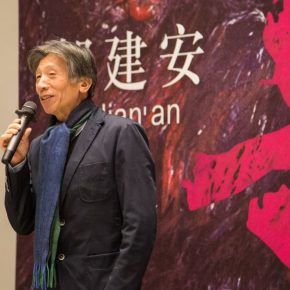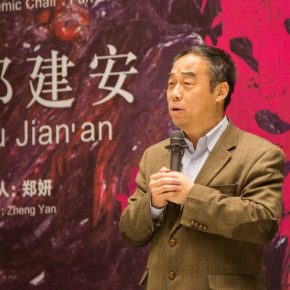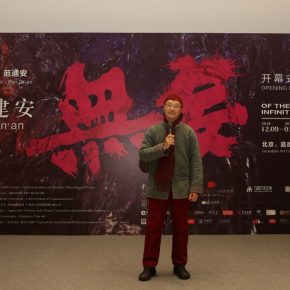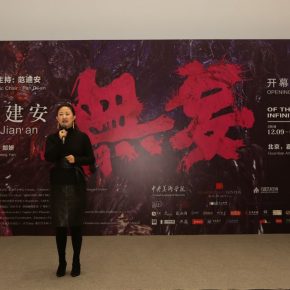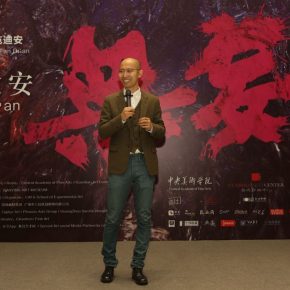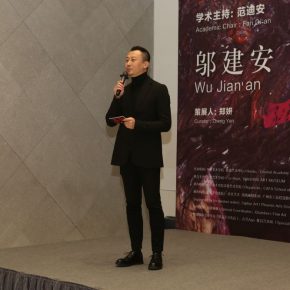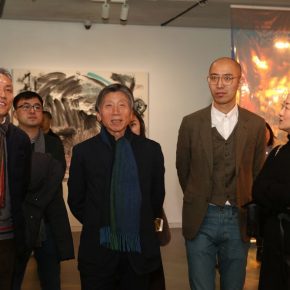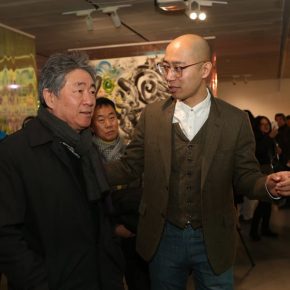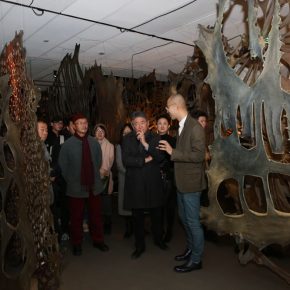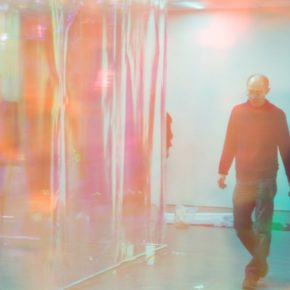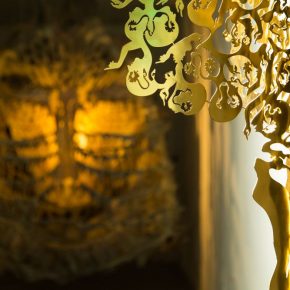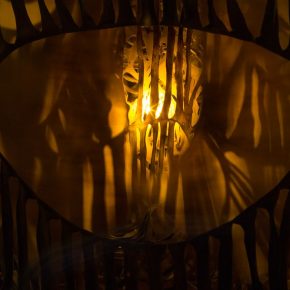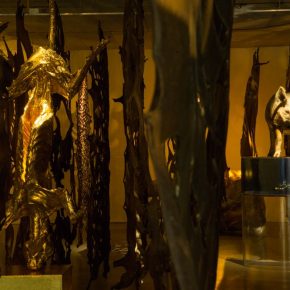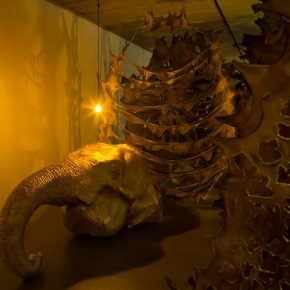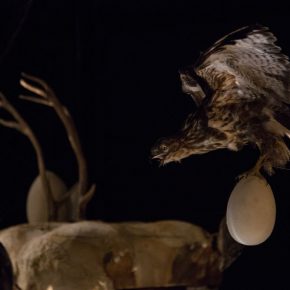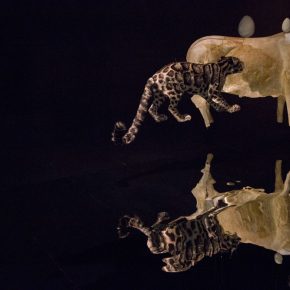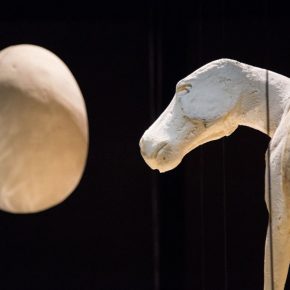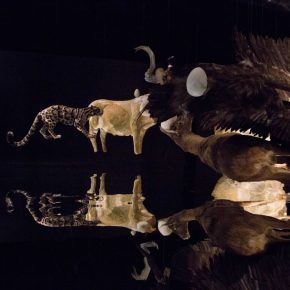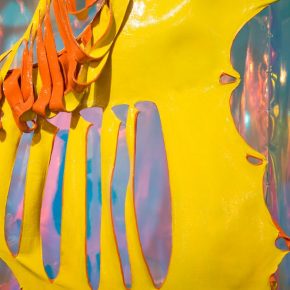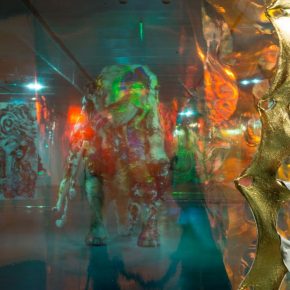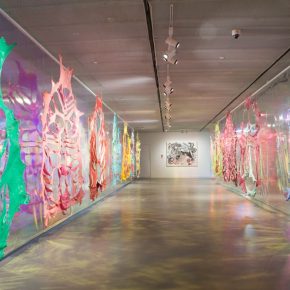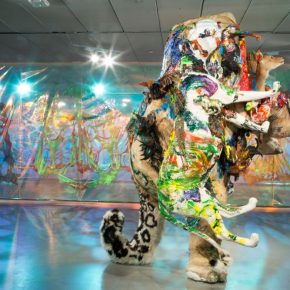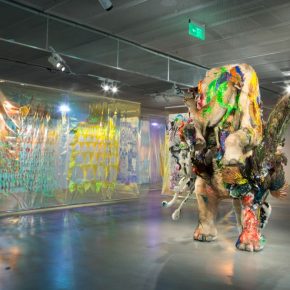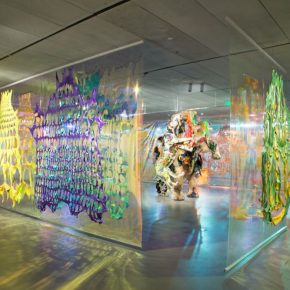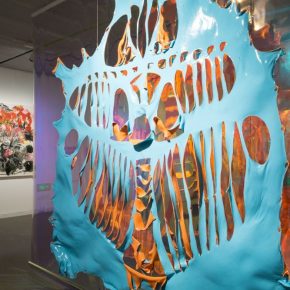
Wu Jian’an , as an artist, started from his textual experience and folk art investigation to establish his own artistic methodology, thus he has opened up a transformation channel between traditional folk culture and contemporary art creation. Like a story teller, he narrates the essence of stories on art, culture and human beings. As commented on by Fan Di’an, President of the Central Academy of Fine Arts, “Wu Jian’an thinks beyond boundaries. He has thought about many metaphysical, abstract but very essential issues on where human beings come from and where they go. By transcending specific story forms and techniques, he traces doctrines floating above shapes.” In 2016, Wu’s solo exhibition Omens told the mysterious and imaginative linear logic narrative that exists in human culture, as strange phenomena appear, indicating magnificent events that are about to happen. Through “omens,” human beings build a “clear” cognition between phenomena and essence, but everything in the world is more “infinite,” and the clarity of the omens are gone. On December 9th, 2018, the exhibition Of the Infinite Mind co-sponsored by the Central Academy of Fine Arts and the Guardian Art Center presented the artist’s unique path in artistic speculation and visual creation through seven series of over 100 pieces/groups created by Wu Jian’an. It also presents his reflection on the history of human civilization and human beings’ existence in history.
The title Of the Infinite Mind (“Wu Wang”) originates in Zhu Xi’s The Texts and Annotations of the Four Books. In the context of Chinese culture, Wu Wang is not only a synonym of truth but also refers to a state of mind that follows the dictates of the heart and breaks free from delusion. “Infinite” refers to a similar “invisible” existence that cannot be specifically defined as it transcends time and space, while breaking through boundary restrictions. From ancient times to today, in what kind of gesture human beings are pushing forward, and what kind of relationship they have established between individuals/groups and everything? This is the developing presentation of the civilization and art. Compared with the solo exhibition Omens at Minsheng Art Museum Beijing two years ago, Of the Infinite Mind is not only a response to Omens but also a continuation. Omens and Of the Infinite Mind are like two sides of a coin, one inadvertently disclosing the designs of the Gods, while the other arrives without a reason. Ancient myths, legends, prophecies, figures… all of these can be interpreted in these two ways in the descriptive system created by Wu Jian’an in the form of contemporary art. Of the Infinite Mind, in fact, is an artistic discovery and spiritual journey close to Tao.
The exhibition consists of three thematic chapters: “Of the Infinite Mind, Unpredictable Maze”, “Viewing the Infinite, the Image of the Creator”, “Infinite and Sincere, the Emergence of Artificial Omens.” The three chapters are independent of the narrative structure, with their own borders, bringing about for the audience a completely different visual experience; the three sections are linear in structure, forming a script about civilization and historical process, cutting the cowhide, and the strange “animal” specimen, the rhythm of ink paintings constitute the image representative of the script, while the interpretation behind it is the thinking of the individuals in the artist’s concept. Light, colors, and the relationship between humans and animals constitute the key entry point for understanding the “Of the Infinite Mind” exhibition and the artistic concept of Wu Jian’an. The entire exhibition thread has the changes of light from dark to bright, colors from plain to dazzling, and the relationship between human beings and animals as an important parameter to reflect on human beings.
“Of the Infinite Mind, Unpredictable maze” is the first part of the exhibition. During the initial entrance, the audience seems to enter a chaotic state, dim light, hundreds of dark leather were hung vertically, weaving into a ruleless labyrinth, and a bizarre “animal” hidden in a certain turning point, seems to come to a ceremonial place in ancient civilization. In Shadows of Knives – Plain Faces, the artist used different kinds of sharp weapons to stab, slice and puncture the soaked buffalo hide to represent the subconscious desire for violence and destruction. Wu has always focused on using a strong visual style to anatomize the spirit world in a direct and truthful way. On one hand, he makes the creations and experiments of visual art meaningful in the psychological and sociological domain; on the other hand, he imparts a feeling of pure unity and astonishing power in his works. Recording the violent and sabotage of human consciousness or the current or the implicit, also implies a kind of instability in human production and creation. The hidden “animals” in the leather labyrinth constitute the “Treasure Series,” they are the golden “elephant heads,” the five-color “deer,” the golden “tiger,” the gold-faced “orangutan,” and the “pig” with interchangeable head and tail. These “animals” have the cultural characteristics of totems. Wu Jian’an explained in an interview that when people have just turned from animals to humans, they are admired by many animals. Compared with some animals, human beings are not strong enough, or agile and fast enough. As the object of worship, they appear to be sacred and mysterious. At this time, the animals are stronger than the human beings, and it is the existence of transcending human beings.
The second part of the exhibition, “Viewing the Infinite, the Image of the Creator” broke with the usual exhibition viewing experience, laying an ink-colored mirror in an open area, a dark space enclosed by rice paper and black flannel, and various “animals” were suspended above the ink mirror pool, it is like a dramatic mythical theater, and the audience overlooks it all. According to the artist's interpretation, this work “Artificial Objects” continues the topic of humans and animals. In the first part, the animals are full of mysterious colors, in a sacred position that transcends the world. With the progress of human civilization, animals have been pulled from the sacred position and become objects that can be mimicked and imitated by human beings, because the “animals” of this part are not natural, but mimetic sculptures made of specimen materials. When human beings begin to imitate the animals in Nature, it means that the desire to challenge the “creator” begins to wake up. In the past cultural experience, this role is generally played by religious or mythological characters.
Through the “Artificial Objects” into the Third Chapter of the exhibition “Infinite and Sincere, the Emergence of Artificial Omens,” into a world of radiance. The main part of this work is the “Mask Series”, which uses almost the same material and creation method as the first chapter, except that in the initial narrative, cowhide is a subconscious destruction, while the cowhide incision is a deliberate image. Operating. The relationship between humans and animals is still a clue to the exhibition narrative. There is a weird “animal” in the center of the exhibition hall. In this work, specimen materials were used by Wu Jian’an as the brush and canvas, and the paint is used as a binder. The various “animals” are glued to the elephant’s body. The “animals” made up of various “animals” are the “omens” of myths that can predict the future. Pigments are the product of human history. In ancient times, the color was scarce. In many places, there was no color, and now various accurate colors can be obtained in a data-based manner. The monster in the exhibition is an omen, which means that the omen becomes an artificial creation. The original image of the myth and legend has become the reality of the material world. This is the determination of the omen, or the innocent emptiness, which is actually unknown.
From “Omens” to “Of the Infinite Mind”, this is the artistic footnote of the mythical text. This is also the interest of Wu Jian’an. Even he cannot explain why by himself there is such great enthusiasm. In his view, a myth is not far away, but our metaphor for the future, we think this is the past, but it is waiting for us in the future. In essence, a myth is a set of interpretation systems of human beings. It is a way of describing people’s own identity and the relationship with the world. The focus of this exhibition lies on the relationship between humans and animals. In an interview, Wu Jian’an said that the relationship between humans and animals is more real than other things. People are actually animals as they are animals that stand up from fauna, but once they stand up, they did not want to be animals again, but they want to become god. Taking “omens” as the narrative object, people come from animals, worshiping animals as sacred, and imitate animals to challenge creation, and then turn the signs of myths and legends into reality, people complete the transformation from animals to people, then to creators, this process is just “of the infinite mind.” Just as the “Warring States Policy, Chu Ce 4” stated: the world has infinite disasters, and there are infinite blessings. Have human beings become the master? Not necessarily, it is just an unexpected state.
The brass sculptures Daydream Forest that evolved from a series of black and white paper-cuts and collages on rice paper inspired by the SARS epidemic in 2003, reveals the individual’s empathetic responses to a crisis in the real world. In addition, the word Wu Wang also represents unexpectedness. The English title “Of the Infinite Mind” expresses this meaning better. Infinite means not clearly-defined, not limited by time or boundaries, like a shapeless existence. In his newly created Rare Treasure and 500 Brushstrokes, Wu managed to present the “infinite” in multiple aspects of his work including concepts, medium, and language. In Rare Treasure, the artist continued to use animal components, added a layer of storytelling beyond figuration and abstraction by transforming materials and rearranging space, creating a mythological scene. In 500 Brushstrokes, he used watercolor and paper-cuts to create collages from vast quantities and styles of brush strokes, turning the two-dimensional image into a space-time concept in which different people meet each other through their brush strokes. In the words of Wu Hung, the distinguished art historian, critic, curator and professor at the University of Chicago, “Individual and unity, ancient and modern, tradition and future, figuration and abstraction, two and three dimensions, words and images……Wu Wu’s imagination naturally merges, rather than fighting against or criticizing these concepts. In other words, he can link opposite concepts.”
For the viewers, unexpectedness creates dual stimulations from the intellectual and sensory dimensions. But for the artist, crossing boundaries, integrating, transgressing and rearranging are not only the methods of creating something unexpected but also inevitable in art practice. “Creating is often accompanied by expectation and fear because you are not sure if you can make it, or even what the result will look like. However, the lack of control in the outcome is the most magical part of art,” Wu Jian’an said.
In the exhibition Of the Infinite Mind, curator Zheng Yan makes full use of the spatial characteristics of the second-floor exhibition hall at the Guardian Center Beijing, to build a new visual arena from the various textures, scales, and styles of Wu Wu's works. On the one hand, it highlights the experimental tension of the works. On the other hand, it provides the audience with an unusual aesthetic and spiritual experience.
“Of the Infinite Mind” presents the creative achievements that artist Wu Jian’an made while transcending mythologies, history and civilization, as well as the channel model between traditional culture and contemporary art. A deeper meaning is that the artist tells a story of civilization, including his reflections on the existence of human beings. The various treatments of light and pigments suggest time clues while the animals’ perspective tear the civilized pseudo ornaments. Through animals, the artist tries to expose something hidden by human civilization, as the infinite mind is hard to hide, it is there, when you see the “animals” at the gallery, you end up with your eyes full of tears. The exhibition also reminds us of his worries on human destiny, as various techniques show us that we are in a chaotic state. We can turn omens into reality through “animal brushes”, which means that we are already in the future, only knowing that changes are ahead but we are ignorant of disasters and happiness.
Text by Zhang Wenzhi, translated and edited by Sue/CAFA ART INFO
About the exhibition
Wu Jian’an was born in Beijing in 1980. He graduated from the Central Academy of Fine Arts in 2005 and is currently an associate professor of CAFA’s School of Experimental Art. His works have been exhibited at the Metropolitan Museum of Art in New York, Museum of Fine Arts in Boston, 4th Fukuoka Asian Art Triennale, the John F. Kennedy Center for the Performing Arts in Washington DC, Central Academy of Fine Arts Art Museum in Beijing, Shanghai 21st Century Minsheng Art Museum, Prince Kung’s Palace Museum, and Beijing Minsheng Contemporary Art Museum. Wu was one of the artists featured at the 57thVenice Biennale China Pavilion in 2017 and was selected to participate in the 2018 Echigo-Tsumari Art Triennale with his 500 Brushstrokes series.
About the exhibition
Dates: 2018.12.09 Sun - 2019.01.05 Sat
Venue: Guardian Art Center
Address: No.1 Wangfujng Street, Beijing, China


